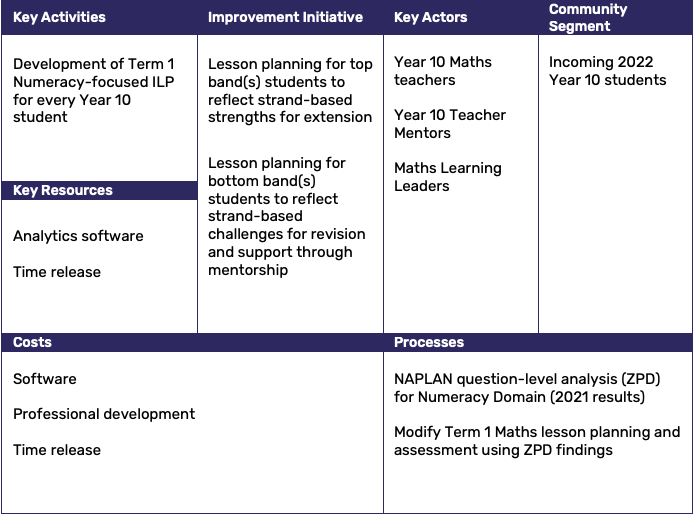When it comes to using data analysis for continuous school improvement, I want to acknowledge something right up-front. Measuring what we care about, what matters — rather than things that are nicely quantifiable — can be really hard. Also, time and resources are finite and not every strategic imperative can make the annual implementation plan. So how do school leaders go about determining what's important and how do we stop making what we can measure from becoming the objective? Well, we could borrow the 'Business Model Canvas' (BMC) from our friends in corporate town.
Consulting on analytics in schools I often found myself in a kind of endless conversational loop. Upon learning that we could get any data a school might want, the school leader would ask, "what can you get?" to which I'd reply, "what do you want to know?" to which they'd parry with "well, what can you get?" I found that in using a BMC, that gridlock could be broken.
What is a BMC?
A BMC is a technique used to build a business model. Developed by Osterwalder & Pigneur in 2010, it's a visual model comprised of nine interlocking blocks, each describing an aspect of a plan which describes aspirations, actions and actors very succinctly. Despite the need to modify it for the education context, I've always found it incredibly useful for distilling which goals are of the greatest value and ways you might capture the information we need to see progress towards achieving them.
A worked example
Rather than lay out Osterwalder & Pigneur's model, I'll list each of the seven (not nine) blocks as I've amended them in my work in education and I'll follow this with the visual model of an actual use case. My intention in illustrating this technique is that you'll see how useful it can be in setting the annual continuous improvement agenda and for bringing clarity to the ways in which data analysis can support your efforts.
My Ed-BMC
The first step is to define our business model root definition. As succinctly as possible, the root definition should tell us (X), what an improvement initiative will do, (Y), how it will do it and (Z), why it should be done (Vigden, Kirshner & Tan, 2019). To illustrate, I'll use one of DEET's prescribed goals for 2022:
Ok, read this less a carefully examined example, and more an illustration of how the operative words by and in order lead you to tightening up the wording of the improvement initiative.
Next, we look at the building blocks of our amended BMC.
1. Community segments are the many different groups of people involved in the school community. A targeted initiative for a continuous improvement agenda should call out that specific group whether it's Year 9s, students transitioning into Year 7, prospective parents or students receiving NCCD funding.
2. Improvement initiative should address a particular issue or seek to add value for the selected group and should state specifically what that need is.
3. Key activities are the critical things the school must do to address the stated aim for the group(s) identified.
4. Processes are mechanisms for delivering the outcome to the community segments.
5. Key actors are the people - members of the staff and/or community who will drive the key activities.
6. Key resources, whether they be people, tools or processes - they are critical to making the improvement initiatives work.
7. Costs describe any costs such as software licensing and professional development which will be critical to achieving the improvement initiatives.
The following is a mocked-up Ed-BMC and I'm aiming for specificity in order to be able to articulate the data requirements to drive the initiative and measure my impact.

Schools will be using many different methods to plan the 'how' of their strategy, this is simply a different technique for doing it. I've found, however, that if this level of thinking and detail is evident then determining how to measure impact using data will be more straight forward.
If you'd like to see how Albitros can instantly and elegantly bring to life the data you'd need for the processes and activities described above, get in touch or schedule a demo with us.